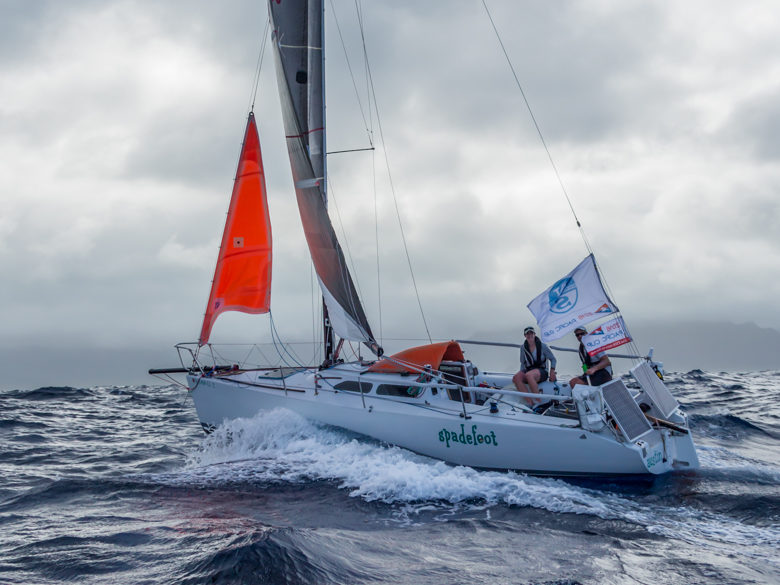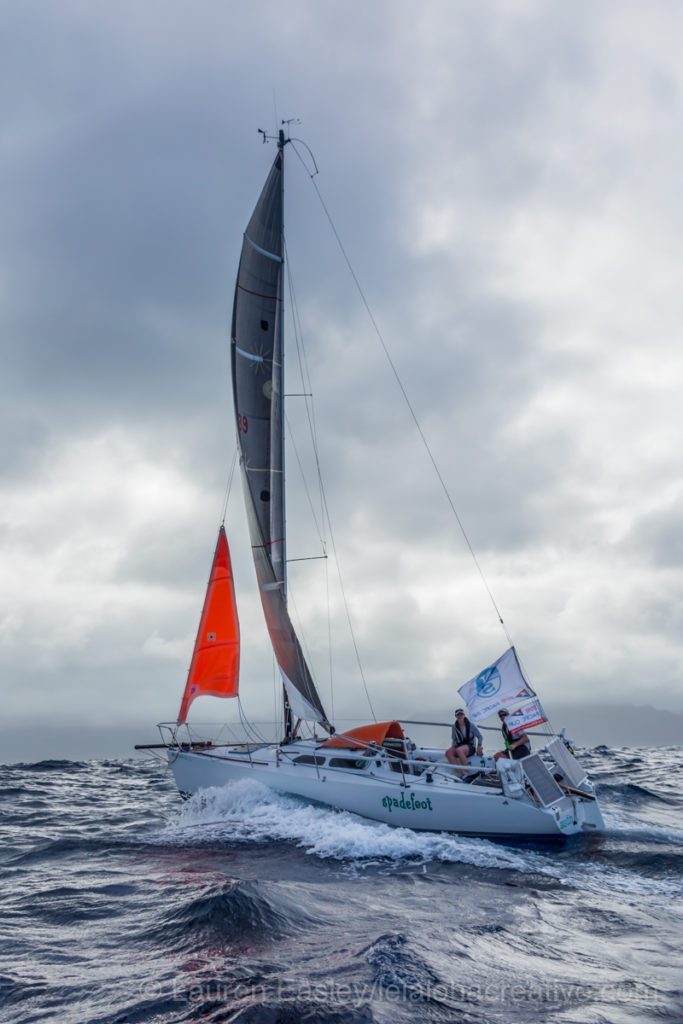Pacific Cup – What Went Well and What Didn’t
August 3, 2016

For those of you thinking about racing across an ocean this might be a helpful:
What went well for us –
- The Jet Boil stove with gimbal worked perfectly. Only 2 small canisters were needed.
- Freeze dried meals for dinner were “good enough”, and one packet was more than the two of us could eat. We didn’t go hungry by any means. We bought a wide variety of meals, ensuring we didn’t get stuck with something we didn’t like. We had string cheese for the first 3 days – it was the thing that tasted best for the whole trip.
- One hour on / one hour off worked surprisingly well as a watch schedule. We found it easy to fall asleep quickly, but also easier to wake up than after sleeping 2 to 3 hours. We also found the one hour on to be much easier. No more bobble heads at the helm trying to make it to the end of a longer shift. I believe shorter naps are a common strategy for the single-handed around the world sailors and they do that for 80-100 days. Had conditions been calmer, the steering would have been easier, and it would have made more sense to get out of our foulies making a longer watch schedule work.
- When we had the A4 up and the waves weren’t too confused, the boat was a rocket. Our best day was 215 nm and that consisted of 8 hours with the A0, 14 hours with the A4, and 2 hours under main only. We never managed a 24 hour run with the A4 up the whole time, but really good numbers (240+) seem quite possible if we could have.
- The Fat Boy bean bag was the most comfortable boat bed we’ve ever had while underway. It allowed us to sleep feet down and head up, so no rolling. It also provided a stunt landing pad when the boat rolled and pitched.
- My Musto HPX boots with gaiters kept my feet completely dry until around day 7. Then I ruined it by sailing for a bit in shorts and boots and got water inside them.
- 160W of solar was more than plenty. We would have been fine with 80W. We did have 2 80W panels running through separate Genasun controllers for complete redundancy, and that still seems like a really good idea.
- The B&G Triton instruments were awesome. Reliable and very easy to read day and night.
- Dramamine – We’ve figured out a way to really make this work. For 2016 seasickness was a big issue on other boats and neither of us had any issues and this has been the case for all of our recent offshore trips. Here’s what we do: 2 nights before the start we take Dramamine, which completely knocks us out, so we sleep like a baby that night. Then the night before the start we take Dramamine again and again we sleep like a baby. By race morning we are over the drowsiness from the Dramamine, but we have a lot of it in our system, so we are good to go. We don’t take any the day of the race or underway as even the non-drowsy version is as good as a sleeping pill.
What didn’t go so well –
- We spent a ton of time making sure we had a robust emergency rudder that was interchangeable with the main rudder, but we never checked to make sure the main rudder gudgeons were secure. They were robust, but there were no lock washers or nylocks.
- The autopilot bracket was screwed into the deck. The only part on the deck that was not through bolted with a backing plate. Since we didn’t plan on using the autopilot, we never inspected this part and didn’t do any testing of the autopilot in rough conditions beforehand. That would have immediately revealed this weakness. As a result, we hand steered 99% of trip, and there were a few hours when the autopilot could have done a good job while we got some extra rest. We lucked out, though, as the autopilot gave us a few hours to fix the bow sprit that required both of us forward at the same time.
- Staying dry. We were wet from the first evening until the finish. We had very good foulies, but constant water on the deck and big waves crashing over the boat eventually found their way down our neck and up our sleeves. A top with gaskets would have helped in this area, but I’ve heard the gaskets also get really uncomfortable after a few days. Being constantly wet took its toll on our backsides. Despite baby wipes and Gold Bond powder we had trouble sitting down by the last day.
- Water inside the boat. We knew water got in through the mast partners despite their being a Spartite boot and a neoprene boot over that. We didn’t realize how much water this would be when the mast was constantly being fire-hosed. As a result we were bailing 5 gallons a day and still had water sloshing around in the bilge. A moveable electric bilge pump might have been the ticket here to get the water out with less effort than a hand pump and sponges. Ironically we had an electric pump, but the rules required us to have two manual pumps, so we disconnected the electric pump and used its discharge hose for the second manual pump.
- Line chafe. The tackline cover chafed through at the rope clutch. Our dyneema bobstay chafed through at the tip of the sprit. The pole extender line chafed through at the aft end of the sprit. All of these could have been foreseen, if we had spent a moment asking ourselves what would chafe. Our dyneema halyards with dyneema chafe protectors didn’t suffer at all.
- No whisker pole. Not having a whisker pole onboard was our single biggest mistake. We could have gone faster for about half the race with less effort if we could have just poled out a jib top or #4. Every double-handed boat poled out a jib at some point, except us.
- Not squaring back spinnakers. It is common wisdom that poling back a spinnaker, even an asymmetric, is fast for VMG sailing to Hawaii. We knew this, but didn’t fully understand the reason until now. Sure sailing low can save distance, but the real benefit is that sailing low allows you to drive straight down the waves. Trying to angle across big waves in a small boat proved all but impossible. Had we had 10-15 knots across the course, the waves would have been small enough that this wouldn’t have been an issue. Lesson learned. I would never sail a small or slow boat to Hawaii without the ability to square back a spinnaker and pole out a jib. Leave the reaching across waves to the fast 40’+ crowd.
- Single reef in the main. Spadefoot isn’t the stiffest boat around, especially with only two people onboard. We had a second dacron mainsail back in Texas with 2 reefs, but didn’t bring it California. Then the forecast was calling for good breeze and we were stuck with the single reefed main. This really cost us the first day as we couldn’t reduce sail enough to head west. We ended up sailing further south (more miles) than any other boat in the fleet on the first day.
Lessons learned!
4 comments
Leave a ReplyCancel reply
Sign up to receive blog updates

The bean bag was an awesome idea.
When you sailed Shearwater you had some cockpit seats. Do you remember where you got those? I don’t see any without arm rests like yours.
Wow…chafe damage in such a short time.
Chuck, the folding seats are from Sport-a-seat. We bought them in 2012. Not sure if they are still around.
The issue with the lines is that all of them were 1.5 years old. Had we looked we likely would have seen early signs of chafe. But we didn’t.
Glad y’all made it! This is also very interesting to read about as well!! Not sure I understand about the line chafe. And also too bad about the auto pilot!
Hi there!!
Thanks for the “What Went Well and What Didn’t”.
This kind of report is always good and enables us to understand from someone’s experience. And, of course to us to avoid on the same issues!!
One tip for one of, at least for me the worst part of a offshore sailing regatta – being wet for a long period.
For that I have two secrets: 1- keep several small towels to put it around your neck, inside the weather’s coat. Not that elegant solution, I know! But it can do a great work on keep your body dry inside.
2 – for the consequences of stay wet for long time, just use pure vaseline. It’s cheaper than other sophisticated stuff and would protect you as much as you need against skin rashes. Is neutral and probably it doesn’t have concerns with alergy and so on. You just have to clean with some fresh water, in order to remove the salt and put the vaseline. To remove; napkins, toilet’ or kitchen’ paper is perfetc.
So, I hope that it can help yu on the next sailing trip!
Regards,
Eduardo
Rio -Brasil